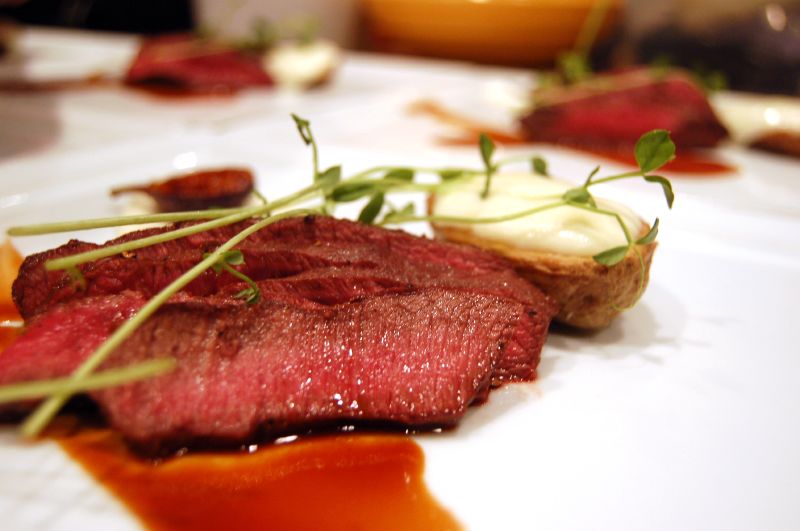Mar 30, 2021
All Up in My Grill – Nagoya’s Best Steakhouses
Considering how highly revered beef is in this country, it may blow your mind to discover that though cows were introduced to Japan sometime in the second century, they were only used as draught animals until the Meiji Restoration (1868) for agriculture and f0r transport rather than eating. But now, ‘wagyu’ (literally ‘Japanese beef’) is renowned for being some of the world’s best.
You can find some amazing steak places in Nagoya. And as well as wagyu, there are also some Western-style steakhouses as well. So, what are you waiting for? Pick up that knife and fork/pair of chopsticks, and get all up in your grill!
Midtown BBQ
Back in 2017, Robb Shannon had a dream to recreate his childhood days, a time when his Grandfather would fire up the grill, and the scent of barbecue would waft through the air, and his uncle would put a pig on the spit, and it would rotate there, succulently roasting.

As such, Midtown BBQ has become one of Nagoya’s go-to barbecue spots, but they also do an amazing selection of steaks, covering the gambit from Scottish Angus steak to filet mignon up to the stupendous 11oz A5 tenderloin.
Where: Nakamura Ward, Meieki, 5 Chome−24−3 Midtown BBQ (map)
Website: midtown-bbq.com
Nikuya Setsugekka
Nikuya Setsugekka’s owner, Tanaka-san, was born to do this. His grandfather raised cattle, and his father was a butcher, and he himself began carving beef from ten-years-old. It was around that time that he dreamed of opening his very own restaurant.

This Michelin Starred restaurant is one of 18 that Tanaka opened, reflecting his unique vision of Japanese yakiniku entwined with a world view. Traditional techniques bringing together original dishes; this is Japanese steak of extremely high quality.
Where: 4-6-23 Meieki, Nakamura-Ku, Nagoya-shi, Aichi 3rd Horiuchi Building B1F (map)
Website: nikuyasetugekka.jp
Indian’s Steakhouse
Putting aside its potentially problematic signage, Indian’s Steakhouse exploded into Nagoya a couple of years back, with chains popping up all over the city amid a flurry of high-profile television coverage. At that time, it wasn’t easy to turn on the TV without seeing some local celebrity gurning with paroxysms of delight as he or she chewed through a massive mouthful of steak.

And massive s the right word. Indian’s Steakhouse is best known for its steaks’ size, and in some branches even run those ‘if you can eat all of this your meal is free’ competitions. But eaters beware, you may think ‘I can eat a cr@pload of steak, no problem,’ the mountain of steak comes with a mountain range of rice. You’ve been warned!
Where: All around the city. Check the website for your nearest.
Website: steakhouse-indians.com
Sue
Pronounced ‘soo-eh’, Sue is very much a local place for local people, and it is perhaps the go-to place for Nagoyans when they want steak. Sue is famed for its T-bone steaks, which is a rarity in Japan, particularly as they use wagyu rather than the cheaper imported meat.

This does mean that it comes at a price – a T-bone will set you back JPY 15,000 and up – but with that expenditure comes a guarantee of quality of the likes that you are unlikely to find elsewhere.
Where: Nagoya, Nakamura Ward, Meiekiminami, 1 Chome−8−18 (map)
Tel: 052-551-5815
What is Wagyu?
Though ‘wagyu’ literally means ‘Japanese beef”, it doesn’t mean that all Japanese cows become wagyu. In butchery, it generally refers to four breeds of cow that are genetically disposed towards the marbling of fat that gives wagyu its sumptuous flavor.
You may have heard a lot of talk about Kobe (pronounced like ‘bay,’ not Bryant) beef, and consider it to be interchangeable with wagyu, but it’s not. Kobe beef – like sparkling wine from the Champagne region – comes from cows reared in the Kobe region, and in fact, it isn’t even considered the best of the best for many Japanese. For many, Matsusaka beef is thought to be superior, while the Imperial family prefers Ohmi Beef.

So, how do you know if you’re getting good wagyu? Well, that’s where the rating system comes in. You might see restaurants advertising that their beef is A5 or A4, which shows the yield of meat a cow will give and the level of marbling fat you might find in the tissue. An ‘A’ rated cow will yield more meat than a ‘B’ rated cow, whilst the higher the number, the more marbling you will find, and as such, A5 is the best of the best.
Think of it this way; in America, you will get cuts ranging from choice to prime. Then, above prime, you’ll find your A4s, and the top of the pile is A5. And if you want to get super technical, if you can find an A5 with a Beef Marbling Standard (BMS) rating of 12, then your head may explode with flavor, and your bank manager may have a heart attack!
Image: by ulterior epicure via flickr.com [CC BY-NC-ND 2.0]
Image: via https://www.instagram.com/p/BNhQoAKgny-/
Image: via https://www.instagram.com/p/CAJ2Eg2nDUP/
Image: by Yoshi-san via tabelog.com
Image: by Allan Salvador via flickr.com [CC BY-NC-ND 2.0]


About the author